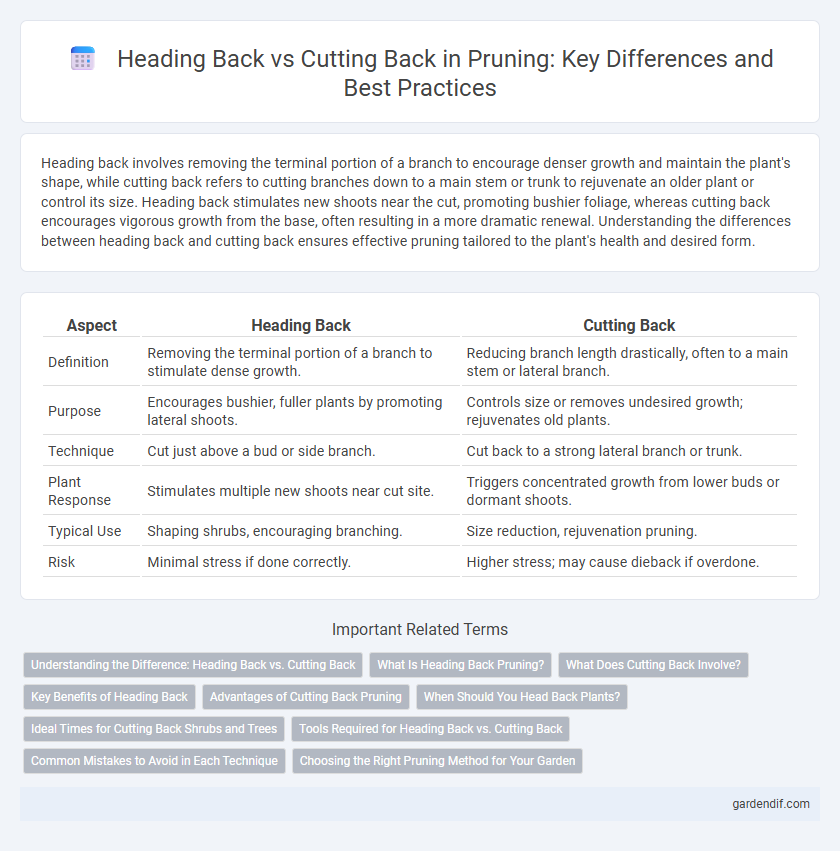
Heading back vs cutting back Illustration
Heading back involves removing the terminal portion of a branch to encourage denser growth and maintain the plant's shape, while cutting back refers to cutting branches down to a main stem or trunk to rejuvenate an older plant or control its size. Heading back stimulates new shoots near the cut, promoting bushier foliage, whereas cutting back encourages vigorous growth from the base, often resulting in a more dramatic renewal. Understanding the differences between heading back and cutting back ensures effective pruning tailored to the plant's health and desired form.
Table of Comparison
| Aspect | Heading Back | Cutting Back |
|---|---|---|
| Definition | Removing the terminal portion of a branch to stimulate dense growth. | Reducing branch length drastically, often to a main stem or lateral branch. |
| Purpose | Encourages bushier, fuller plants by promoting lateral shoots. | Controls size or removes undesired growth; rejuvenates old plants. |
| Technique | Cut just above a bud or side branch. | Cut back to a strong lateral branch or trunk. |
| Plant Response | Stimulates multiple new shoots near cut site. | Triggers concentrated growth from lower buds or dormant shoots. |
| Typical Use | Shaping shrubs, encouraging branching. | Size reduction, rejuvenation pruning. |
| Risk | Minimal stress if done correctly. | Higher stress; may cause dieback if overdone. |
Understanding the Difference: Heading Back vs. Cutting Back
Heading back involves trimming the terminal portion of a stem or branch to promote dense, bushier growth and often results in multiple shoots emerging from a single node. Cutting back refers to removing entire branches or stems down to a main point or trunk, stimulating vigorous regrowth and rejuvenating the plant's structure. Understanding the distinct outcomes of heading back versus cutting back is essential for effective pruning strategies tailored to plant health and aesthetic goals.
What Is Heading Back Pruning?
Heading back pruning involves cutting the main stem or branches of a plant back to a bud or lateral branch, encouraging denser growth and more compact shape. This technique stimulates the plant to develop multiple shoots near the cut site, enhancing overall bushiness and vigor. Unlike cutting back, which removes entire branches or stems to the base, heading back targets specific points to control size and direct growth.
What Does Cutting Back Involve?
Cutting back involves removing entire branches or stems from the base or main structure of a plant to control size, shape, and promote healthy growth. This technique differs from heading back, which involves trimming the tips of branches to encourage denser foliage. Proper cutting back helps rejuvenate older plants and stimulates new, vigorous shoots while preventing overcrowding.
Key Benefits of Heading Back
Heading back in pruning stimulates vigorous new growth by cutting branches just above a bud, resulting in denser foliage and improved plant shape. This technique enhances air circulation and light penetration within the canopy, reducing disease risk and promoting overall plant health. Heading back also enables precise control over plant size and encourages a bushier, more compact structure compared to cutting back.
Advantages of Cutting Back Pruning
Cutting back pruning stimulates vigorous new growth by removing older branches, which improves the plant's overall shape and structural integrity. This method enhances air circulation and light penetration, reducing disease risk and promoting healthier foliage. It also encourages increased flowering and fruit production, making it ideal for garden revitalization and productive plant maintenance.
When Should You Head Back Plants?
Heading back is effective when plants become leggy or overgrown, stimulating bushier growth and a more compact shape. Cut back is better suited for rejuvenating older, woody plants by removing dead or excessive growth to encourage new life. Head back plants in early spring or after flowering to promote healthy branching and improve overall plant structure.
Ideal Times for Cutting Back Shrubs and Trees
Ideal times for cutting back shrubs and trees vary by species but generally occur during late winter to early spring before new growth begins. Deciduous trees are best pruned while dormant to prevent sap loss and minimize stress, whereas flowering shrubs often require pruning right after blooming to preserve next season's flowers. Cutting back in these optimal periods supports healthy regrowth and maintains plant shape effectively.
Tools Required for Heading Back vs. Cutting Back
Heading back primarily requires sharp pruning shears or loppers to make precise cuts just above a bud or branch junction, promoting strong, compact growth. Cutting back involves more robust tools like pruning saws or hedge trimmers to remove larger sections of branches or entire stems for major reshaping or rejuvenation. Selecting the appropriate tool based on branch thickness and pruning goal ensures clean cuts that minimize plant stress and encourage healthy regrowth.
Common Mistakes to Avoid in Each Technique
Heading back often causes excessive regrowth and weak branch structures, as many gardeners mistakenly cut too close to the bud, leading to stress and reduced plant vigor. Cutting back mistakes include removing too much foliage at once, which can shock the plant and inhibit flowering or fruiting. Proper identification of the target branch and understanding growth patterns are essential to avoid damaging the plant during both heading back and cutting back.
Choosing the Right Pruning Method for Your Garden
Choosing the right pruning method depends on the plant type and growth goals, where heading back promotes bushier growth by cutting the stem above a bud, while cutting back involves removing larger portions to rejuvenate or control size. Heading back is ideal for shaping and encouraging dense foliage, whereas cutting back suits older, overgrown plants needing revitalization. Understanding plant response and seasonal timing ensures effective pruning that supports healthy development and long-term garden vitality.
Heading back vs cutting back Infographic

 gardendif.com
gardendif.com